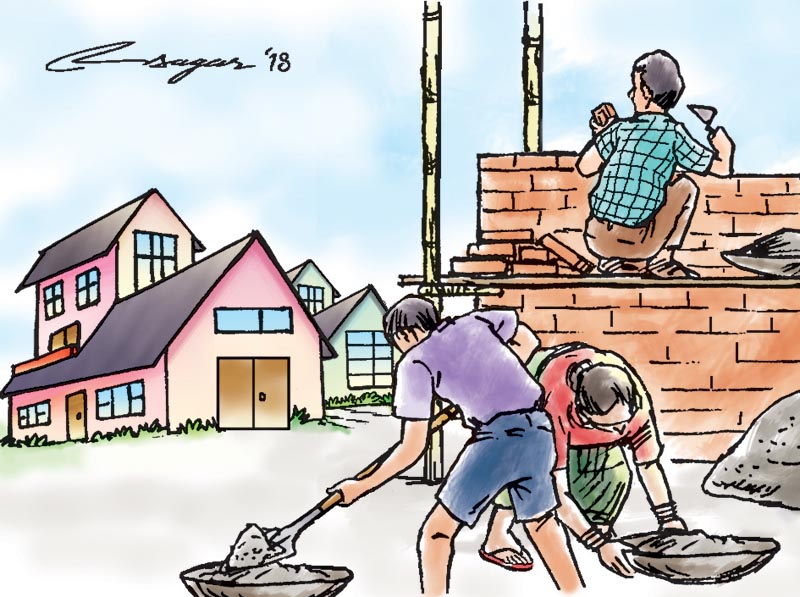Unstirred but vulnerable: Focus on seismic safety
Natural disaster can strike anytime, so we have to work now to ensure that those who were not affected by the earlier disaster do not have to pay a heavy price during the impeding natural hazards. We have to invest today to become more resilient
More than a million building stocks were stirred by the 2015 Gorkha Earthquake and its subsequent aftershocks. As we commemorate the third anniversary of the devastating earthquake, it is once again time to think and talk about what we have done in the last 36 months to reconstruct and rehabilitate and what we have not done when it comes to those structures that survive the disaster.
The agencies involved in reconstruction and rehabilitation, it seems, have failed to widen their spectrum from “trial and error” approach to pragmatic methods. “Quake-resistant construction” has been the refrain, which echoes everywhere – from the peaks of Dolakha to the terraces of Makawanpur.
There is neither effective mechanism nor technology. Nor do we seem to be working with accountability. Our entire reconstruction process seems to be overwhelmed by “quake-resistant” phrase. During a recent conference, when I questioned the whole idea of using “quake-resistant building”, the entire panel burst into murmurs: “that’s a great technology”.
It will be unfair to say that no progress has been made in post-quake reconstruction. But the moot questions are: Do our buildings really fit into the category of “quake-resistant”? What should people expect in terms of performance level? An immediate occupancy? Life safety? Or collapse prevention?
Nobody seems to be aware of these.
Emotions and whimsical remarks have in majority cases have set the foundation of our reconstruction process with science conspicuously absent. “Improved construction technology” instead should have been the right approach.
I wonder if the houses that are being rebuilt or have been rebuilt indeed ensure people’s safety. A through technical audit could mean a bigger shock.
Let’s talk beyond the ongoing reconstruction process.
Nearly five million buildings across Nepal were unhurt by the Gorkha Earthquake. But no substantial strengthening measures have been taken for them. Studies conducted since 2011 highlight that buildings that were not shaken by the Gorkha Earthquake are more vulnerable than those which were shaken.
Keeping abreast of the status of the unaffected buildings is a grave challenge as the earthquake three years ago does not mean we are not prone to similar shock(s) again in the future.
The region behind Gorkha, especially the middle and high mountains to the west, has stone masonry buildings, which are amongst the most vulnerable building classes of Nepal, according to a recent research paper that I authored.
Subsidies or amortized loans are immediate needs. Ensuring safety to the people beyond the perimeter would undoubtedly downsize the damage in the case of future earthquakes and other natural hazards.
That reinforced concrete ensures earthquake resistance is a fallacious assumption. The majestic Sinja valley architecture and upper Dolpo building stocks, the Ghumaune Dhi of the western middle mountains, Kudule houses of western middle mountains and the hybridised Churia housing stocks, among others have justified features to cope with prevailing natural hazards in the specific regions; there is a need of some minor modifications in the features to ensure life safety during natural disasters.
Some budget techniques are already there, while some more are evolving. Identification is the first task.
At times, emotion has ruled out science, as people overly emphasise local techniques terming them “genius features” which they say “quake-proof”. It is not only advisable but mandatory that having quite a few aspects of earthquake resistance does not ensure life safety.
Every technology that is argued as resistant should be objectively discussed and performance level should be marked. The building code should ensure adequate safety and serviceability.
Plans currently endorsed and implemented lack adequate quality control framework. So is the case in the case of existing building stocks across the country. Periodic condition assessment by technicians is a must to ensure the desired performance level.
Solving the problems with local knowledge is the best way forward – not only to avoid the gawky construction in the remote mountains but also to ensure that refurbishment and local reconstruction are eased in the future.
The government has the sole responsibility of keeping the citizens safe. Investment in structural and infrastructural safety should be from the governmental side as well. Before that, remarkable investments should be made in research activities.
Desultory construction throughout the country must be checked.
We need to eye beyond the districts that were affected by the Gorkha Earthquake and make a resolution to strengthen the existing buildings either under subsidised or amortized frame.
Natural disasters can strike anytime, so we have to work now to ensure that those who were not affected by the earlier disasters do not have to pay a heavy price during the impeding natural hazards. We have to invest today to become more resilient tomorrow.
Gautam is a researcher in structural earthquake engineering






